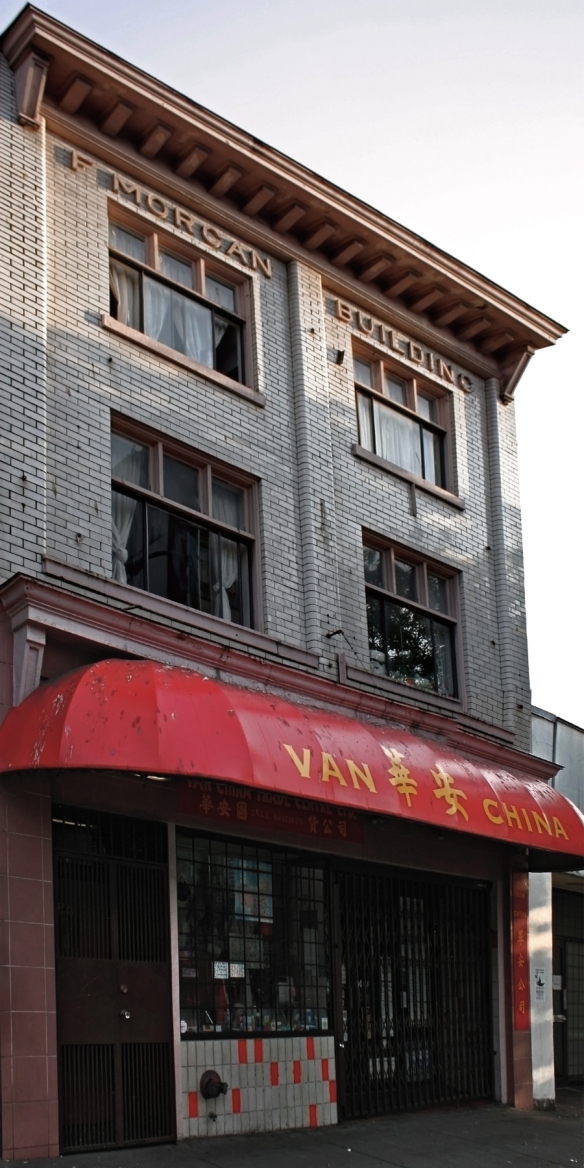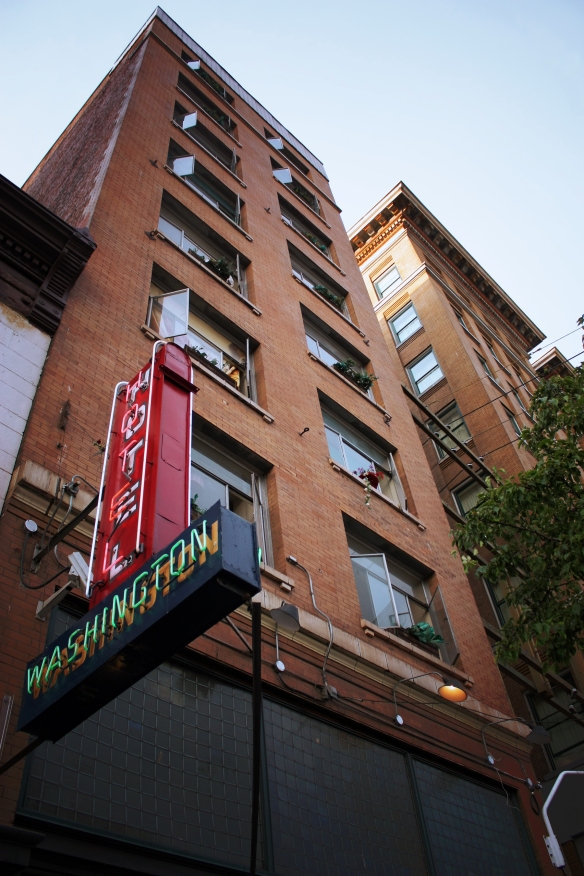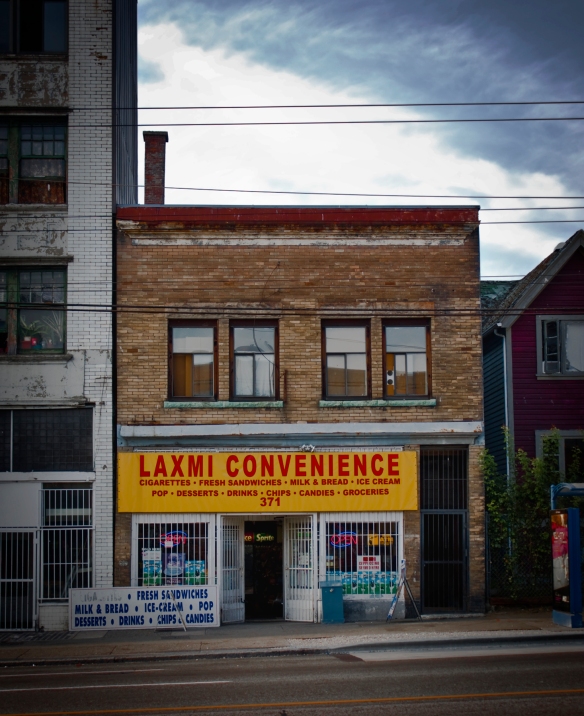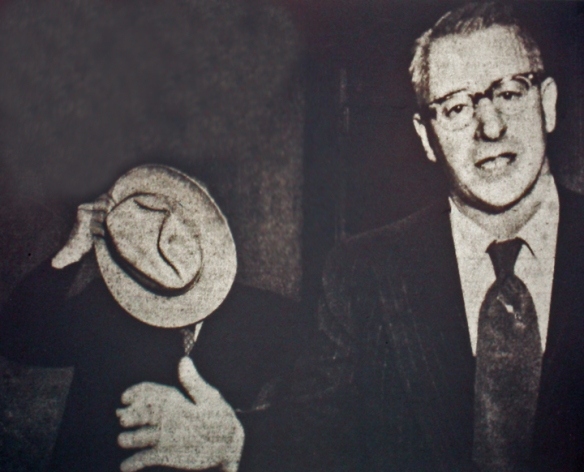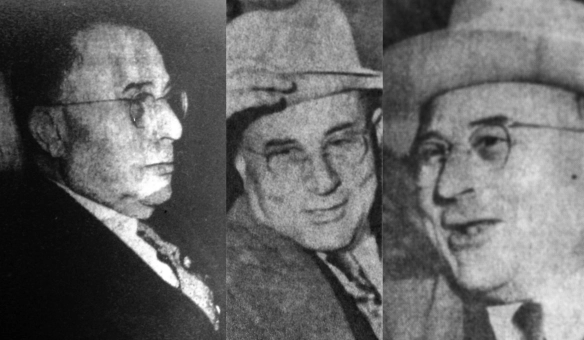
Police triggered a riot after attempting to clear the street at this 1932 demonstration organized by the Vancouver Unemployed Workers' Association. Photo: Vancouver Police Museum #P06048
The Great Depression hit Vancouver like a hammer. The city already suffered chronic high unemployment owing to the seasonal nature of BC’s resource-based economy, and even in the supposedly prosperous 1920s, Vancouver was known as a “Mecca for the unemployed.” After the economic collapse, people who couldn’t find work at home drifted to Terminal City in unprecedented numbers.
For the Communist Party of Canada, the unemployment crisis was the beginning of the party’s heyday. Communists took the lead in organizing unemployed workers as part of their “Third Period” strategy of growing a revolutionary union movement under the banner of the Workers’ Unity League (WUL). Formed barely a month after the stock market collapse, the Vancouver Unemployed Workers’ Association (VUWA) was the first WUL unemployed organization in what eventually became a network of similar groups across the country.
The VUWA’s first big action was a march to City Hall on December 5th, 1929 to present its demands to Alderman Atherton. At the time, there were an estimated 10 to 14 thousand unemployed in Vancouver. The VUWA claimed it had 1000 members, 500 of whom participated in the march, including one woman. Newspapers reported that it was an orderly affair and that although there was a police escort, protesters “showed no disposition toward action beyond making their representations to Ald. Atherton.” After the visit to City Hall, 700-800 protesters gathered at Maple Tree Square where VUWA leaders James Litterick and William McEwan addressed the crowd from a soap box, congratulating them on “the silence and orderliness of the parade and exhort[ing] them to accept work at $1 a day for single men and $2 a day for married men, but not to be satisfied with that but to press for a full union wage.”

James Litterick (left) and Communist Party of Canada bigwigs, Tim Buck and Sam Carr. Litterick was recruited by the Communist Party while unemployed and on the streets of Vancouver in 1927. Along with William McEwan, he founded and led the Vancouver Unemployed Workers' Association at the beginning of the Depression before moving to Manitoba where he became the first Communist MLA.
The demand for union wages for work on relief projects around the city was a key demand of the VUWA. Unemployed men were, after all, doing the same work for which unionized City workers received $4.50 per day. In this sense, the unemployed served the City as an inexpensive pool of scab labour that undercut civic workers. Other demands included an end to discrimination against relief workers based on residency requirements, race, and nationality, and for relief payments to be made in cash, not in kind. (Relief, what we now call welfare, was administered by municipal governments at the time).
In what would become a familiar refrain throughout the Depression, Alderman Atherton pleaded poverty to the delegation. “Where will we find the funds?” he asked. “Do you realize that if we do all you ask, we will have three times as many unemployed here next year?” In response, McEwan
urged that the city must not hide behind the cloak of the Dominion government to evade providing for the immediate needs of the great army of unemployed and should bring pressure to bear upon the federal and provincial authorities to find a permanent solution to the problem.
After this relatively cordial beginning, the relationship between the authorities and the unemployed quickly deteriorated. For the sake of keeping the peace, Chief Constable WJ Bingham had agreed to overlook the Communists’ refusal to carry the Union Jack during their marches in violation of a City by-law, so long as protesters did not carry red flags.
Bingham explained to the police board that he changed his mind after receiving information that VUWA was planning a “window-smashing campaign” on Granville Street as part of one of their upcoming protests. “In order to avoid this,” he said, “I instructed the Unemployed that, whilst I was prepared to allow them to hold their meetings, an unauthorized procession could not be permitted.”
According to historian Todd McCallum, VUWA believed “Bingham’s legal right to prevent parades under city by-laws was superseded by the rights of assembly and free speech bestowed upon all citizens.” On December 16th, 500 unemployed protesters “stormed” the Relief Office where they debated with George Ireland, the head of the relief department, and chanted “No Scab Jobs!” Police dispersed the crowd after an hour and half, so they marched to City Hall where they attempted to crash a council meeting, but were again thwarted by police.
On December 18th, VUWA secretary William McEwan was arrested and exposed as Allan Campbell, a Scottish-born Communist. Chief Bingham refused a permit for a march to the immigration office on Burrard Street. They did anyway, only to be met by a line of mounted police who dispersed the crowd by force. For his agitation amongst the unemployed, Campbell was deported back to Scotland.
VUWA had also begun to organize workers on relief gangs working on the various work projects throughout the city. In response, relief boss George Ireland arranged with Chief Bingham to have paid informants and undercover police hired on as relief workers.
Word soon got around that police spies were posted on relief gangs, which only added to the discontent of the unemployed. In one example, Special Constable Frank Godber reported that a spy named Ogilvie was going from gang to gang pretending to be a Communist in order to collect information. Several unemployed men noticed him with Ireland in the relief office pointing out agitators to be fired from the work gangs. Godber reported that “the men wanted to wait for him & beat him up, but better judgment prevailed.”
As an unintended consequence of the stool pigeon system, police spies got to experience first-hand the crappy treatment the unemployed were subjected to by the City’s relief department. In his report to the chief, Constable Eric Hichens complained about one clerk he encountered while working undercover. The clerk was, in Hichens opinion,
a supercilious fool and an insufferable prig, totally unfit to come in contact with a body of men … After making some sarcastic remarks to men proceeding me, he considered it part of his privilege to say to me ‘What do you do for a bed, beg it or steal it,’ – I merely replied ‘Steal it.’ One man who was near me said to me, ‘The bloody bastard, if he had spoken to me like that I would have knocked the shit out of the fucker’ … The manner in which the [clerk’s] remark, and others were made, were such as to be likely to cause a breach of the Peace. They were not said in any tone of bantering, such as men use among themselves, in which accusations of the foulest immorality may be made as a joke to be passed over and forgotten, as in the Army: but in a manner most offensive and aggressive.
Hichens and at least one other spy were fired without pay from the relief gangs by George Ireland. (As for Ireland, he would himself eventually be fired from the relief department and imprisoned for skimming money from the relief funds and taking kick-backs from restaurants authorized to accept the 25¢ meal tickets issued to relief recipients.)

Front page of the Unemployed Worker, organ of the Vancouver Unemployed Workers' Association. City of Vancouver Archives, VPD fonds, series 199, 75-F-2, file 1
VUWA’s attempts at organizing relief workers and orchestrating a strike were unsuccessful (but valuable experience for later efforts). The group’s main focus was on public protests, marches, and mass meetings, which frequently involved skirmishing with the police. One protest at the Powell Street Grounds on January 27th, 1930 drew much criticism from trade unions and the general public about the police department’s handling of unauthorized protests. In a letter to the editor of the Vancouver Sun, Robert Hartley wrote a scathing letter on behalf of the Carpenters’ Union denouncing police brutality:
The spectacle of well-fed, clad and paid, strong and healthy policemen beating up undernourished, poorly clad and shivering working men, who because of vile conditions and starvation rations, dared to protest in public, is one that no right thinking citizen can afford to ignore. The police certainly acted in a brutal and cowardly manner, but the principal blame for the disgraceful affair should be laid where it belongs, on the shoulders of those responsible for the administration of affairs in the City of Vancouver … Surely the administrative ability and humanitarian principles of those in control must be of the poorest character, when they have to resort to the primitive methods employed by their hirelings on the Powell street grounds.
The melee began after VUWA organizers signaled the beginning of a march from Powell Street Grounds in defiance of Chief Bingham’s orders. Within minutes, mounted police attacked the crowd with lead-tipped whips. Polly Karinsky, one of only a few women in attendance, allegedly fought back by clubbing one of the officers with a stick. An undercover officer in the crowd was also injured by another policeman who didn’t recognize him as one of their own. The crowd dispersed up Dunlevy Street where a funeral procession that was getting underway inadvertently got mixed up in the clash. One of the mourners was punched in the ribs. Chief Bingham later dismissed her complaints because she had been “an out-patient of the Hospital for years. It is clear that this allegation is merely another effort to counter the action of the Police enforcing the law.”

Police dispersing a gathering of the unemployed at Victory Square, July 1932. City of Vancouver Archives #Re N2.2
Over the next couple of years, the VUWA organized numerous public meetings, parades, and rallies to press their demands. Police responded with constant surveillance, dispersing crowds, and arresting agitators and protesters whenever they had the chance. Chief Bingham and his successor, CE Edgett, argued that the “whole situation was due to the activities of a few Communists clearly out for trouble.” In other words, the thousands of unemployed protesters had no legitimate reason to protest, but were instead being duped by the leaders of VUWA.
Meanwhile, ratepayer associations criticized the police for not sufficiently policing the rest of the city; one group called for the RCMP to be called in to deal with crime. The papers gave the impression that a crime wave was sweeping the city, which Chief Bingham blamed on the unemployed. In response to a Sun campaign urging the police to attend to the crime wave, Bingham and Mayor Malkin claimed that about one-third of crimes being reported were bogus and intended to make the police department look bad.

Leaflet publicizing a demonstration at the Powell St Grounds protesting "this fascist effort to suppress by force meeting of the unemployed workers." City of Vancouver Archives, VPD fonds, series 199, 75-F-1, file 14
VUWA used the attacks on free speech and assembly to their advantage. “This fascist effort to suppress by force, meeting of the unemployed workers must be vigorously combated not only by the unemployed but by the whole working class population,” read one of their pamphlets. Another leaflet was sent to the homes of the entire city police force urging them to remember their working class roots:
Have you forgotten your working-class origin? Have you lost your working-class instincts and associations? Will you continue to bludgeon and imprison those who once called you fellow-worker? Or will you refuse to be the hireling of capitalism? Refuse to beat up the unemployed! Throw your baton away, leave the dirty work to the Binghams and [Mayor] Taylors. Let them do their own clubbing.

The Vancouver Unemployed Workers' Association mailed this leaflet to the homes of every rank and file member of the Vancouver City Police Department, appealing to them as fellow workers to stop clubbing the unemployed at demonstrations. City of Vancouver Archives, VPD fonds, series 199, 75-F-1, file 14
A hunger march in the spring of 1932 turned out to be one of the biggest and most violent demonstrations/riots involving the unemployed in Vancouver. It was held in conjunction with a meeting in Ottawa between representatives of unemployed organizations across the country and Prime Minister RB Bennett. While James Litterick was in the nation’s capital arguing for unemployment insurance against a prime minister insisting that Canada already spends more than other countries on the unemployed, 5000 people, including 250 women, gathered at the Cambie Street Grounds.
After listening to speakers denounce all three levels of government for failing to address the unemployment crisis, a few thousand proceeded to march to City Hall, then located in the Holden Building at Hastings and Carrall. They arrived to find 18 police guarding the entrance to City Hall. A couple minutes later, twelve mounted city police came around the corner at Abbott Street. Then twenty-three Mounties came riding around the corner and flanked the other side of the demonstration.

Demonstration organized by the Vancouver Unemployed Workers' Association outside City Hall in 1932. Photo: Vancouver Police Museum #P00886
Armed with flags, banners, and placards, the crowd cheered, jeered, and sang “The Red Flag.” Streetcars were soon backed up to Main Street, and mounted police proceeded to corral protesters onto the sidewalk. Their horses became excited, leading the crowd to hoot and holler even louder. The police retreated, and then fanned out and headed towards the throng of protesters right in front of the City Hall doorway. “For a moment the Red banners seemed to hold their ground,” reported the Sun. “Then came a mighty surge of humanity along the street and along the sidewalk.”
People fled, ducking into doorways to avoid the onslaught. “Then an officer’s long black baton was seen to collide with the sickle-and-hammer flag of Red Russia, the loftiest of the banners in view,” according to the Sun,
and in a moment pandemonium reigned … Thirty-five mounted constables rode up and down the street, swinging their long sticks … Then the unemployed’s standards could be seen slashing in the mob. The banners fell off and the bare poles became weapons that hammered at the officers’ heads. Groups of rioters battled knots of horsemen.
It didn’t take long for the police to successfully break up the crowd, especially after another contingent of horsemen from the BC Provincial Police arrived. The street was littered with red flags, banners, and broken glass. Much of the crowd, however, returned to Cambie Street Grounds with mounted police hot on their trail. Some protesters escaped up the fire escape at the Central School (where VCC is today, behind Victory Square). Skirmishing continued, but baton-wielding police managed to drive the protesters away.
In the final tally, eleven arrests were made and three protesters and three police were treated for injuries in the hospital.
Chief Constable Edgett claimed that he allowed the parade only on the condition that there not be a demonstration after the march. VUWA organizers broke faith, he said, and so there would be no more unemployed protests allowed. Besides, noted the Sun, with all the red flags and no Union Jack, the parades were illegal anyway according to City of Vancouver by-law No. 1475.
Mayor LD Taylor was furious with Chief Edgett for allowing the riot to happen and not consulting with him beforehand. He contrasted Edgett with ex-Chief Bingham:
Bingham, with all his faults, knew how to handle crowds. They can say what they like about him, but he used to come down with his men, not sit in his office smoking good cigars, while his men were out withstanding the mob.
Taylor added that Chief Edgett should have read the Unemployed Worker. If he had, said Taylor, he never would have allowed the parade in the first place. In an article describing another hunger march a few days earlier, VUWA bragged about having forced Edgett’s hand and getting council to grant them meal tickets, explained Taylor. Had Edgett read this, or consulted with him, the whole riot could have been avoided. (Taylor would eventually fire CE Edgett for inefficiency.)
The pattern had become familiar by 1932. The riots, parades, and demonstrations in the context of intransigent governments and aggressive police may have continued for the duration of the decade if the hoped-for final solution to the unemployed problem had not been set in motion.
Instead of shaping solutions based on the grievances expressed by the unemployed, the problem was increasingly framed as an issue of Communist agitation and street disorder. Isolating unemployed men in remote concentration camps literally removed the problem of urban unrest. Relief camps were initially established by the Province, but would soon be taken over by the Canadian military. Order was temporarily restored, but the authorities were unable to stop organizing and agitation amongst the unemployed, and by 1935, a relief camp strike brought the issue back to the fore in Vancouver and public opinion became overwhelmingly sympathetic to the plight of the unemployed.




